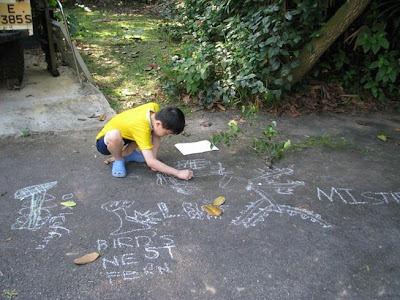Tuesday 14 July 2009
Upcoming: Fun with Colourful Crabs at Chek Jawa
Time: 8am - 11 am
Location: Chek Jawa, Pulau Ubin. Meet at Changi Point Ferry Terminal (next to Changi Village)
Coordinator: Gloria Seow. Register at gloria_seow AT yahoo.com
Colourful pincers waving in the air, feeding crabs are everywhere. Plenty of multi-coloured fiddler crabs colonise the mangroves and beaches of Chek Jawa (Pulau Ubin), clothed in electrifying colours if you care to look closely. Help Tan Hang Chong and Timothy Pwee spot these tiny crustaceans and learn fascinating facts like how their burrowing promotes nutrient cycling. We will also get to observe the much talked about marine life of Chek Jawa which will be exposed during the low tides. Meet at 8 am at the Changi Point Ferry Terminal. You will need to bring $9 per person to cover the return ferry fares to Pulau Ubin ($5) and the return van ride to Chek Jawa ($4), excluding registration fees. Please register your kids (4 to 12 years old) with Gloria at gloria_seowATyahoo.com, stating their names and ages, if you are a NSS member or not, your mobile number, and if you need us to provide binoculars or not (to see the tiny crabs). A fee of $5 per child (member) or $10 per child (non-member) will be collected on the spot. Parents are encouraged to come along at no charge. Details will be emailed to those who sign up.
Fun with Plants that Grow on Other Plants
 Margie explained the difference between epiphytes and parasites to kids and their parents.
Margie explained the difference between epiphytes and parasites to kids and their parents.Margie Hall’s black-and-white bungalow in Sembawang was the perfect place to view plants that grow on other plants (known as epiphytes and parasites) as they flourish at eye level in her lush garden. Kids had an enjoyable morning touring this little Eden on 6 June 2009 to gawk at the fascinating array of mistletoes, ferns, fungi, mosses, lichens and orchids that festooned the branches and trunks of various trees and shrubs.
 The Wrightea plant was festooned with semi-parasitic mistletoes.
The Wrightea plant was festooned with semi-parasitic mistletoes.So what’s the difference between epiphytes and parasites? Epiphytes use the host plant as support only (to reach the sunlight), while parasites not only use the host plant as support, but take food and water from it as well.
 Margie’s cutters snipped through the mistletoe’s haustorium (the connection of the mistletoe with the Wrightea) and lots of ants started pouring out!
Margie’s cutters snipped through the mistletoe’s haustorium (the connection of the mistletoe with the Wrightea) and lots of ants started pouring out! Kids saw how several types of local mistletoes Dendropthoe, Macrosolen and Viscum, considered semi-parasites, almost snuffed out the life of their host plant the Wrightea in Margie’s garden, by stealing food, water and sunlight from it. They learnt how the Scarlet-backed Flowerpecker played a part in this process – this tiny bird eats the mistletoe berries whole, but excrete the undigested seeds as sticky dung on the Wrightea’s branches, which germinate into more invasive mistletoes. The poor Wrightea was not only heavy laden with these plant semi-parasites, but even had mistletoes parasitizing on other mistletoes growing on it! As a result, its leaves were much smaller than their usual size and the Wrightea was slowly dying. Margie then cut off some branches with mistletoes on them, snipping through the roots and cross-section of the haustorium (the connection of the mistletoe with the Wrightea). Lots of ants began to pour out – apparently the spaces between the roots, haustorium and Wrightea branches were also cosy ant houses!
 Luxuriant Oak-leaf and Rabbit’s-foot ferns.
Luxuriant Oak-leaf and Rabbit’s-foot ferns.
We had various non-plant diversions, like hearing the tantalizing song of the Straw-headed Bulbul, one of the kids finding the moult of a cicada, admiring pretty butterflies as they weaved in and out of flowers, and best of all, observing the tree-hole nest of the Coppersmith Barbet through the scope, thanks to the sharp eyes of Morten Strange, author of numerous bird books, who was there with his son Mark.
Margie’s driveway then became a huge drawing board when kids were invited to sketch their favourite epiphytes and parasites with coloured chalks. Soon enough, the black bitumen was full of cutesy doodles. Kids being kids, they could not help but play tic-tac-toe and draw stuff like a mile-long caterpillar too!
